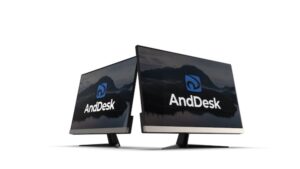
After more than 40 years of operation, DTVE is closing its doors and our website will no longer be updated daily. Thank you for all of your support.
AndDesk: time for the Smart Monitor OS
 Much of the attention of the TV world is currently focused on the opportunity afforded by connected TV and related commercial opportunities. Smart TVs provide a rapidly evolving distribution opportunity for content providers and TV manufacturers have been keen to capture a share of this growing market.
Much of the attention of the TV world is currently focused on the opportunity afforded by connected TV and related commercial opportunities. Smart TVs provide a rapidly evolving distribution opportunity for content providers and TV manufacturers have been keen to capture a share of this growing market.
But the TV is not the only screen in the home. With home working on the rise and large groups of people living in constrained spaces, many people are substituting monitors for TVs. Monitors as a category of device to meet both home and workplace requirements are growing in importance and increasingly serve, for many people, as their prime window to the digital world.
Unsurprisingly then, the traditional monitor market is growing rapidly.
Device manufacturers in this space traditionally compete on quality of display – high-quality visuals, screen size and resolution, and energy efficiency – as well as on price.
Recently, manufacturers have also differentiated monitors on software, but with a focus primarily on intuitive menus to manage display-related settings.
More recently, a new category of monitor has emerged – the Smart Monitor – which includes software to support a range of workplace and entertainment functions independent of the screen being tethered to a laptop or other device.
Some of the giants of the Smart TV World are actively involved in the Smart Monitor space – notably Samsung and LG. The category has been defined to a large extent by the TizenOS-based Samsung M8, which creates a self-sustaining entertainment hub on the foundation of a basic display device by including access to entertainment apps such as video streaming services as well as providing wider access to the web, voice control and smart home integration.
It remains the case that the bulk of monitor and TV manufacturers have yet to look at the potential offered by this what is very much an early stage category of consumer equipment whose evolution remains to be shaped.
Enter AndDesk
The result is a market that is opening up and which currently is only being addressed by two CE giants – Samsung and LG. Samsung effectively created the category, most notably with the M8. Neither of these technology giants is likely to dilute their grip by licensing Smart Monitor software to third parties.
That leaves monitor providers that lack the scale of the giants with a dilemma. Do you want to enter the Smart Monitor space, given the balance of risk and reward?
iWedia’s answer was to create AndDesk, an independent Smart Monitor OS, that will give monitor manufacturers access to a scalable operating system that can provide a high level of functionality to enable both productivity/workplace and leisure/entertainment applications.
According to Zivko Radonjic, Senior Business Development Manager at iWedia, the company decided to take a traditional product – the monitor – and completely re-dimension it so that could be competitive with TVs, rather than take a TV and remove the tuner to create a tuner-less TV that could also function as a monitor.
In developing its own Smart Monitor operating system, Radonjic says, iWedia took the view that this was likely to be of high interest to monitor manufacturers working in an industry characterised by low margins and little in the way of software expertise.
While it is a low margin market, the monitor market overall is worth about US$50 billion in revenue and is still growing.

Zivko Radonjic
For consumers with living space constraints and limited financial resources – also a growing category – combining the functions of monitor and TV makes sense. Delivering a product that spans both worlds and provides added value both for consumers and for manufacturers could therefore prove to be a winner.
“Having a video platform built into the monitor, perhaps with advertising and all the functions that are today becoming popular and which are generating new revenue streams could really awaken the market,” says Radonjic.
The aim, he says, was to develop a proposition that spanned productivity or workplace requirements associated with the PC world, such as the ability to support Microsoft Office and tools to enable video-conferencing on one hand, and entertainment services associated with the TV world and gaming on the other.
“This is an OS that you can download and on which you can install these applications, which will work on the device perfectly with your camera and with externals like a keyboard and mouse or headphones,” says Radonjic.
The vision, he says, was to create a platform that could support productivity, social and workplace interaction, leisure pursuits such as cloud gaming and entertainment services such as popular video streaming apps.
For manufacturers, access to an independent OS designed specifically to support Smart Monitor functionality means being able to retain control over the software within their own products. It means being able to customise or optimise the user interface according to their own requirements and brand vision. It enables monitor manufacturers to address their own unique customer requirements and tailor their products to the needs of specific addressable market segments.

Android-based design
AndDesk is based on the Android Open Source Project (AOSP).
“The reasons for choosing Android are obvious,” says Radonjic. “We have 15 years’ experience with Android – we have been involved with Android TV since the very beginning. It is an open standard, with millions of developers around the world, and you have the amazing app ecosystem, with who knows how many apps available on the free Google Play Store.”
This plays to one of the other key benefits an independent Smart Monitor OS can bring to the market – enabling manufacturers, on their own or together, to build their own app ecosystems, forging partnerships with app developers and content providers.
Radonjic emphasises the point that iWedia’s technology is a “monitor OS” rather than “a modified or customised TV OS” that brings major points of differentiation . The company built it from scratch with workplace or productivity applications in mind. All technology in the platform has been designed and created in-house. The look and feel of the monitor interface can easily be customised. The product is highly differentiable.
Monitors underpinned by AndDesk could support workplace applications such as Google Drive or Microsoft 365, and communication apps such as MS Teams, Zoom or Webex, alongside entertainment apps such as Netfix, YouTube or Amazon Prime, games and connectivity apps such as WhatsApp.
Radonjic says that iWedia has held talks with a broad range of industry players, encompassing SoC vendors as well as OEMs of both monitors and TVs.
“We are talking to SoC vendors, we are talking to monitor vendors, and we are talking to TV vendors. Maybe some of the TV vendors would like to start producing monitors, and maybe SoC vendors would like to have a turnkey solution to offer to monitor manufacturers,” he says.
Significant addressable market
While the appeal of this new category of device remains to be scoped, Radonjic believes there will be a significant addressable market among consumers. This can range from people who live in small apartments and lack space to accommodate a large TV screen but need a device both for work and play, to students and people looking for combined devices for rooms other than the main living space in their homes. While some users may connect their monitor to a computer, others may look to the Smart Monitor itself as their device for work in the home.
“You could have a Smart Monitor that you only use as a monitor attached to a computer, or you might use it as a Smart Monitor when your kids borrow the laptop and you still need access to some workplace applications,” he says.
As a company working in the TV middleware space for 15 years, iWedia has a base of existing clients and technology partners for whom this may well be of interest.
“We started talking to people right after CES and we currently are demonstrating it all around the world with SoC vendors, TV manufacturers and monitor manufacturers,” says Radonjic.
For SoC vendors, he says, there is the potential to develop a turnkey solutions for OEMs, with the software adding to the value of the hardware.
“Everyone understands that this might be revolutionary, and they are taking it step by step, but the feedback we are getting is very positive,” he says.
This is sponsored content.